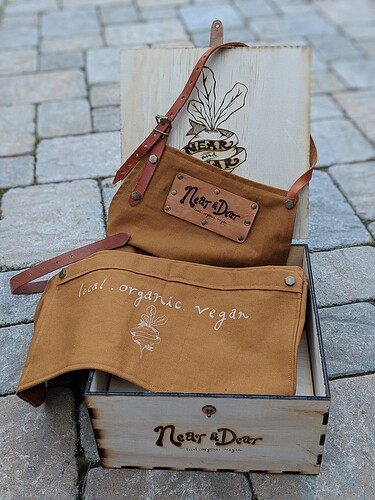Made some items (apron and bakery box) for my daughter’s new baking business and the results were better than expected. My first foray into lasering on duck cloth canvas and I was pleasantly surprised at the results. I expected it to be a brown “burn” engraving but instead it turned out bright white! Crisp, clean and the integrity of the fabric does not seem to be affected. I’m thrilled at the prospects of hundreds of canvas applications! The leather engraving was nice too.
Oh, very nice! I like the white text on the brown! 
Very nice! That is one snazzy apron indeed! I’m sure she’ll be very pleased.
Oh, good to know, I have some duck cloth I bought to make a cover of my laser. I will have to give engraving a go before I make it.
Nice how that came out white on the cloth. Gives one ideas…
Very cool! Amazing the happy surprises different colored media have when etched–I wonder if the laser etched off the dye layer and thus exposed the raw cotton underneath? And love the leather detail and rivets on the apron. As @arh2 noted, gives one ideas…
Exposing of the raw cotton underneath the dye is the only logical explanation. Such a fine fine line between exposing and going right through the fabric. Truly amazing how precise this machine is.
You won’t be disappointed!
Fabulous creations…brought forth by fantastic machine. Love what you made!
This is what I’ve experienced from some types of book cloth, so this wouldn’t surprise me at all!
Many pigments are relatively fragile molecules. Also, the way pigments work is that they absorb certain frequencies while reflecting others. (The color you see depends on which pigments are reflected.) A low-powered engraving can break down the pigments without affecting the fabric because the colored pigments absorb the laser while the white cotton reflects it. (Although obviously if the power is set too high or the speed is too low the laser eventually heats up the cotton enough to burn it.)
Of course not every pigment is going to absorb the IR frequency generated by the CO2 laser so some colors may not be bleached as effectively. (In laser tattoo removal they use a variety of lasers with different frequencies; different colors of tattoo ink respond well to different types of laser.)
The breakdown products of different pigments are typically white or grey, but some pigments may turn brown or black. You may get different results with different colors of fabric. (Or even with similar colors that happen to have been dyed with different pigments.)
This particular color combination is beautiful, as is your design! I absolutely love how the apron turned out!
Where did you get the fabric from? This looks amazing!!
I sourced the fabric from Joann fabrics. Very inexpensive and lots of colors
Thank you for such a detailed explanation, really helps me wrap it around my brain.
What at an awesome gift … I’m sure she was thrilled!
Oh, very nice indeed! Gives all of the pieces such a professional look.
I absolutely love this.
Where did you get the rivets? Especially the hex ones
Thanks! I got the Rivets on Amazon!
That apron is badass - show us more pics! People will pay good money for those. Great work!
This is really nice looking. Thank you for sharing.
